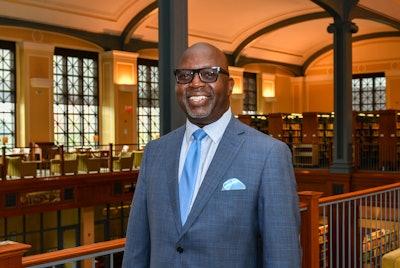 Dr. Bernard J. Gantt
Dr. Bernard J. Gantt
“College student attendance patterns this spring compared to spring 2024 are reinforcing and building on the growth that we saw in the fall,” said Dr. Doug Shapiro, executive director of the National Student Clearinghouse Research Center (NSCRC), which released its report on spring 2025 enrollment. “Spring enrollments continue their progress towards recovering the levels of spring 2020.”
The current enrollment is a 3.2% increase from spring 2024. Undergraduate enrollment grew by 3.5% but still remains below pre-pandemic levels.
Community colleges play a significant role in the increase in undergraduate students, showing a 5.4% increase (288,000 students) over spring 2024. Total enrollment numbers remain down from 2020.
Dr. Bernard J. Gantt, vice president for enrollment management at Bronx Community College (BCC, a City University of New York institution), said BCC is seeing consistent growth. While first-time freshman numbers dipped slightly, there have been notable increases in transfer students, up 7%, and continuing students, up 4%.
“Bronx Community College experienced a 5% year-over-year increase and an 8% gain since spring 2023,” said Gantt. “This growth reflects strengthening student interest in accessible, flexible (i.e., online programs), and career-aligned education (i.e., health-related programs) following years of pandemic-related declines.”
NSCRC data shows that institutions focused on vocational/trade programs saw especially large gains for the third consecutive year at 11.7%. These programs now account for 19.4% of public two-year enrollment. Shapiro noted that students are going for shorter-term credentials at lower cost with more direct job-related skills.
“[BCC] is seeing strong momentum in alternative pathways like nondegree programs and dual enrollment, reinforcing BCC’s strategic focus on flexibility and re-engagement. Preliminary data also shows a strong rebound in fall 2025 enrollment growth,” said Gantt.
 Dr. Suri Duitch
Dr. Suri Duitch
“In 2021, Kingsborough Community College embarked on a bold and strategic mission to expand access, opportunity and representation by increasing its Hispanic student population—paving the way to become a federally recognized Hispanic Serving Institution,” said Duitch. “As of spring 2025, that vision has come to fruition, with Kingsborough now designated an HSI.”
Increases at four-year institutions are smaller, at about 2.5% this year, with larger growth at public institutions than private. White undergraduates halted a years-long slide with a 1.8% increase, the first increase in this demographic since 2020. Black and multi-racial students grew the fastest among all racial and ethnic categories that were tracked, with 10.3% growth for Black undergraduate students and 8.5% for multi-racial.
Dr. Shawn P. Fagan, assistant vice provost–student success at Temple University, a Research 1 institution, said the university saw an increase in undergraduate fall 2024 enrollment over the previous two years. There was a marked increase among first-generation students and students of color in applications, admissions and enrollment.
Fagan noted that every student that comes to Temple has the academic ability to succeed, but especially post-pandemic they may be behind in college literacy (how to navigate higher education). Also, many colleges and universities still expect students to come into an office if they have questions about financial aid or other issues. This is especially challenging for first-gen students and serving them is key to sustaining enrollment.
“Changing our mindset in how we serve these students and trying to meet them where they’re at, instead of the traditional way of ‘if they need help with their courses, they’ll walk into their advising office,’” said Fagan. “Trying to think intentionally and strategically on how we serve these students and how we can draw them into our services instead of waiting for them to come and ask for help.”
Enrollment at Historically Black Colleges and Universities (HBCUs) increased by 4.6% for undergraduates this spring and 7.7% for graduate students, which continues a growth trend for HBCUs. “[The data] counters some of this narrative that HBCUs are in trouble,” said Shapiro.
Nationally graduate enrollment increased by 1.5% and is 7.2% higher than it was in 2020.
“More than in recent decades, institutions must evolve to offer compelling programs and a meaningful student experience,” said Duitch. “If prospective students do not find value and inspiration in what colleges offer, they may opt out of higher education altogether. However, it is clear that college pays off; individuals gain significant social and financial benefits from earning college degrees.”

